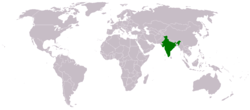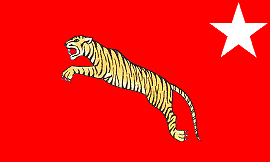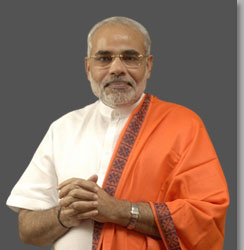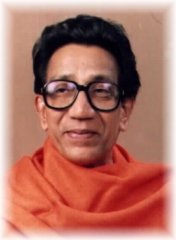Indian Social Republic
From Roach Busters
| Indian Social Republic | |
| | |
 | 
|
| Flag | Emblem |
| | |
| Motto "Ittefaq, Itmad aur Qurbani" (Hindustani) "Unity, Faith, and Sacrifice" | |
| | |
| Anthem Vande Mataram (I bow to thee, Mother) | |
| | |

| |
| | |
| Capital Largest city | Kolkata 22°55'N, 88°33'E Mumbai |
| | |
| Official languages | Hindi (de jure) English (de facto) |
| | |
| Demonym | Indian |
| | |
| Government - President - Vice President - Prime Minister | Parliamentary republic Single-party state Jaibhan Pawaiya Uddhav Bhatkhande Keshav Upadhyaya |
| | |
| Independence - Declared - Recognized | from the United Kingdom October 21, 1943 August 15, 1947 |
| | |
| Area - Total - Water (%) | 3,165,922 km² 1,222,369 sq mi 9.56 |
| | |
| Population - 2008 estimate - Density | 553,711,787 175/km² 453/sq mi |
| | |
| GDP (PPP) - Total - Per capita | 2008 estimate $3.626 trillion $6,548 |
| | |
| GDP (nominal) - Total - Per capita | 2008 estimate $5.47 trillion $9,879 |
| | |
| Gini (2004) | 57.7 (high) |
| | |
| HDI (2006) | |
| | |
| Currency | Indian rupee (INR)
|
| | |
| Time zone - Summer (DST) | IST (UTC +5:30) not observed (UTC +5:30) |
| | |
| Internet TLD | .in |
| | |
| Calling code | +91 |
India, officially the Indian Social Republic, is a country in South Asia. It is one of the largest countries in the world, in both population and area. Bounded by the Indian Ocean on the south, the Arabian Sea on the west, and the Bay of Bengal on the east, India has a coastline of 7,517 kilometers (4,671 mi). It borders Pakistan to the west; China, Nepal, and Bhutan to the north-east; and Bangladesh and Burma to the east; it also borders France via Pondicherry (which is claimed by India). The disputed Northern Areas of Jammu and Kashmir claimed by India and currently administered by Pakistan shares a small border with Afghanistan to the extreme northwest. Sri Lanka, Maldives, and Indonesia are in India's vicinity in Indian Ocean.
Home to the Indus Valley Civilization and a region of historic trade routes and vast empires, the Indian subcontinent was identified with its commercial and cultural wealth for much of its long history. Four major world religions, Hinduism, Buddhism, Jainism and Sikhism originated here, while Zoroastrianism, Judaism, Christianity and Islam arrived in the first millennium CE; however, in the present day Hinduism is the only legal religion, and all religious minorities are in the process of being deported. Gradually annexed by the British East India Company from the early eighteenth century and colonized by England from the mid-nineteenth century, India became a modern nation state in 1947 after a long struggle for independence which culminated in a violent revolution and a brief but bloody civil war, which was followed by the country's partition into India and Pakistan; the coming to power of a fascist regime, which maintains power to this day; and one of the world's most infamous genocides, which resulted in the death of tens of millions of Muslims.
India is one of the largest economies in the world, but its economy is largely isolated by the government's autarkic policies and the refusal of most nations to trade with India due to ongoing human rights abuses and an economic climate unfavorable to foreign investment.
As a pluralistic, multilingual, and multiethnic society, India is also home to a diversity of wildlife in a variety of protected habitats.
Contents |
Politics
India is a parliamentary unitary republic in which the governing political party, the People's Revolutionary Hindu Nationalist Party (PRHNP), enjoys a monopoly on power, as provided by the constitution. The country is universally described by analysts abroad as a "fascist dictatorship," but India describes itself as a "revolutionary authoritarian democracy" and does not consider itself to be fascist.
The PRHNP
The PRHNP is, as mentioned previously, the only legal party in India. Membership is compulsory for all citizens aged 16 or older. Established in 1939 as the Indian Nationalist Party (and renamed in 2008), the party's platform incorporates extreme Hindu nationalism, radical right-wing populism, anti-imperialism, reactionary social values, and dirigisme. It openly repudiates both capitalism and communism, because the former is said to place individuals above the community while the latter is said to be too community-oriented and stifle individual development.
The party adheres firmly to corporatism as a means to prevent class struggle and supremacy of economism, and believes in the necessity of control over the forces of economic modernization in order to defend the religious and rural values of the country. The party rejects class warfare and instead emphasizes class collaboration, arguing that the preservation of social hierarchy is in the interests of all classes, and therefore all classes should collaborate in its defense; both the lower and the higher classes should accept their roles and perform their respective duties. The stability and prosperity of the nation is seen as the ultimate purpose of collaboration between classes. The party argues that dirigisme is the correct economic path, and that the state should exert strong directive influence, effectively control production and allocation of resources, mediate relations between classes, and achieve economic self-sufficiency. While the party is tolerant of private enterprise, it demands that all economic activity should serve "the national interest." It also supports social programs and other populist measures as a means of winning over the working class and retaining their support.
The party platform "acknowledges Hinduism as not only the faith, but the very lifeblood of the Indian Nation" and advocates a government and society organized completely in concordance with Hindu philosophy.
Social conservatism is also emphasized. The party supports a hierarchical, male-dominated society organized along rigid caste lines, and vehemently opposes such "social vices" as homosexuality, pornography, fornication, gambling, and drugs.
President
The head of state of India is the President (currently Jaibhan Pawaiya), who is elected indirectly through the electoral college to a five year term, with a limit of two terms (however, the terms must be consecutive). The Constitution sets the principal qualifications to be eligible for election as President. A Presidential candidate must:
- be 50 years of age or older;
- be a natural-born citizen of the Indian Social Republic;
- have been resident in the Indian Social Republic for at least twenty years
Powers and functions
While in theory the President has vast powers, in practice he is a figurehead limited to performing mainly ceremonial functions.
The Constitution vests in the President of India all the executive powers of the central government. The President appoints as Prime Minister the person most likely to command the support of the majority in Parliament (although in practice, the President appoints whomever is elected General Secretary of the Indian Nationalist Party at its tri-annual congress). The President then appoints the other members of the Cabinet, distributing portfolios to them on the advice of the Prime Minister.
The Cabinet remains in power "at the pleasure of the President."
The President is responsible for making a wide variety of appointments. These include:
- Governors of States
- The judges of the People's Court
- The Attorney General
- The Comptroller and Auditor General
- The Chief Election Commissioner and other Election Commissioners
- The Chairman and other Members of the Union Public Service Commission
- Ambassadors and High Commissioners to other countries
The President also receives the credentials of Ambassadors and High Commissioners from other countries.
The President takes part in foreign visits and concludes treaties with foreign nations.
The President is the de jure Commander in Chief of the Indian National Army.
The President of India can grant a pardon to or reduce the sentence of a convicted person, particularly in cases involving punishment of death.
The decisions involving pardoning and other rights by the President are independent of the opinion of the Prime Minister or the Parliament. In most other cases, however, the President exercises his or her executive powers on the advice of the Prime Minister.
The President summons Parliament and prorogues it. He can even dissolve the Parliament. These powers are formal, and by convention, the President uses these powers according to the advice of the Prime Minister.
The President inaugurates the Parliament by addressing it after the general elections and also at the beginning of the first session each year.
A bill that the Parliament has passed can become a law only after the President gives his assent to it. When the Parliament is not in session and the government considers it necessary to have a law, then the President can promulgate ordinances.
Finally, the President can declare three types of emergencies:
- National emergency
- State emergency
- Financial emergency
In the event of an emergency, the President can suspend civil liberties and rule by decree (although in practice, the Prime Minister would do so on the President's behalf).
The President is expected to be impartial and non-partisan, and for the most part, rarely involves himself in day-to-day politics. While in practice he has little to no power, he still commands great respect among Indians and serves an important role as a symbol of national unity.
Vice President
The Vice President (currently Uddhav Bhatkhande) is first in the line of succession, meaning that if the President dies, he assumes the position. He also serves as Acting President if the President becomes temporarily incapacitated or is otherwise unable to perform his normal duties. He essentially serves as a "spare wheel," for the President, and has no official duties or functions.
Prime Minister
The head of government of India is the Prime Minister (currently Keshav Upadhyaya), in whom the constitution invests with central executive authority. His authority emanates both from the provisions of the constitution and from his status as General Secretary of the INP, of which he is ex officio leader.
The Prime Minister determines the composition of the cabinet. The President formally appoints and dismisses cabinet ministers, at the recommendation of the Prime Minister; no parliamentary approval is needed. The Prime Minister sets the number of cabinet ministers and dictates their specific duties. He is responsible for all government policies and any formal policy guidelines issued by him are legally binding directives that cabinet ministers must implement. Cabinet ministers are expected to introduce specific policies at the ministerial level that reflect the Prime Minister's broader guidelines.
While in theory the Prime Minister's actions must at all times be in full concordance with the constitution (which has been suspended since 1953), in practice he wields dictatorial powers and governs as he sees fit, with no checks, balances, or other restraints on his authority.
Cabinet
As of April 2008, the members of the cabinet are:
Minister of Agriculture, Fisheries, and Rural Development: Vijay Vivekananda
Minister of Aviation: Kodandera Manekshaw
Minister of Broadcasting, Publicity, and Propaganda: Ganapathi Thackeray
Minister of Commerce and Industry: Rahul Mallya
Minister of Culture, Religion, and National Heritage: Adityanath Kaswan
Minister of Economics: Dr. Raj Malhotra
Minister of Energy, Mines, and Natural Resources: Sellapan Sarangapani
Minister of Finance: Dr. Amartya Chaudhuri
Minister of Foreign Affairs: Abhishek Rai
Minister of Forestry, Environment, and Water Management: Rajendrasinh Kusmaria
Minister of Health and Public Safety: Dr. Pyarelal Nayak
Minister of Housing and Urban Development: Lal Singh
Minister of Infrastructure: Arun Panikkar
Minister of Interior: Rajkumar Joshi
Minister of Justice: Amitabh Samrat
Minister of Labor and Employment: Devdas Ashram
Minister of Posts and Communications: Jual Naik
Minister of Science and Education: Srinivasa Ranganathan
Minister of Social Welfare and Pensions: Ramkrishna Lodha
Minister of Transport and Shipping: Jayaprakash Nehru
Minister of War: Subhas Appadurai Bhonsle
Parliament
The bicameral Parliament of India is the supreme legislative body in the country. Any bill can become an act only after it is passed by majority vote of the Parliament and assented by the President. The Parliament is comprised of the Lok Sabha ("House of the People"), the lower house, whose members are directly elected by popular vote to four-year terms (there are no term limits), and the Rajya Sabha ("Council of States"), the upper house. Half of the Rajya Sabha's members are elected by the legislatures of State and Union Territories, while the other half are appointed by the President. The members chosen by State and Union Territory legislatures serve for six-year terms and are limited to two terms (which must be consecutive), while the members appointed by the President serve for life.
All candidates for the Lok Sabha are hand-picked by the government, and there is only one candidate per constituency, meaning that, rather than choosing between different candidates, voters are offered only one candidate and two options: "Yes" or "No." However, voting is done by open ballot, and the presence of security officers at the polls means that nearly 100% of voters choose "Yes." Suffrage is universal and compulsory (and enforced) at age 18.
Not surprisingly, the Parliament is a largely powerless body which exists solely to rubberstamp the Prime Minister's decisions.
People's Court
The People's Court of India is the highest court of the land, and operates outside of the constitutional frame of law. The court has jurisdiction over a rather broad array of "political offenses", which include crimes like black marketeering, work slowdowns, and defeatism. These crimes are viewed by the court as "disintegration of defensive capability" and are accordingly punished severely. The death penalty is meted out in numerous cases in this court.
Politically-reliable appointees dominate the court, which has never ruled against any action taken by the government or questioned the constitutionality of any of its laws.
State and local governments
India is a unitary state in which all power is concentrated at the federal level. State and local governments have no autonomy and exist as mere administrative divisions. State governments are appointed by the State President, while local governments are directly elected. Both state and local governments are beholden to the federal government, and are charged with implementing and executing its decisions at the state/local level.
Subdivisions
States:
|
|
Union Territories:
|
India is comprised of twenty-seven states and seven Union Territories. Each state or union territory is divided into districts. There are nearly 600 districts in India. The districts in turn are further divided into tehsils and eventually into villages.
Foreign relations
to be added
Economy
India has a complex economic system that defies easy categorization. The Indian government itself adds further confusion by its ambiguous description of its economy as "neither capitalist, nor socialist, nor in between." Various political analysts abroad, depending on their own personal political leanings, describe India as "socialist," or "state capitalist," depending on who one asks; however, there is near-unanimity in their description of India as corporatist and dirigiste. State intervention in the economy, whether on behalf of politically-connected corporations (many of which are granted legal monopolies in recognition of their services to the regime) or on behalf of the workers whom it claims to represent, is pervasive.
Labor
Price and wage controls are strictly enforced. Workers' wages are artifically set to a low level, while prices are set to a high level. The purposes of this are two-fold: To ensure that workers are required to work as many hours as possible, to ensure that they have neither the time nor the energy to dissent; and to maximize the profits of politically-connected corporations. Strikes and collective bargaining are illegal and, when they do occur, are ruthlessly suppressed. All salaried and wage workers are required to join the Indian Labor Front. Trade unions are outlawed. The government maintains at least nominal support of the workers by providing generous pensions, subsidized healthcare and housing, paid vacations, and other benefits.
Budget and public works
Interest rates are kept at an artificially low level, while government budget deficits are kept high; the large budget deficits are used to fund massive public works projects, including national highways, railroads, dams, canals, and other infrastructure. As a result, unemployment in India is almost non-existent. Conscription and public works ensure that jobs, both skilled and unskilled, are plentiful.
Trade
The government's adherence to "self-reliance," and "economic independence," i.e. autarky, means that the country's trade with the outside world is kept to an absolute minimum. Foreign investment in India is strongly discouraged. Tariffs are among the highest in the world, and Indian businesses are massively subsidized. Farmers, too, enjoy generous subsidies, which serves to both protect Indian agriculture from foreign competition and win the support of farmers for the government. The government has attempted to make up for the lack of trade by adopting a policy of import substitution, with mixed results.
State-owned enterprises
Several public sector corporations exist, all of which enjoy monopolies in their respective areas. Examples include the Oil and Natural Gas Corporation, National Thermal Power Corporation, Bharat Heavy Electricals Limited, Indian Railways, Steel Authority of India Limited, National Fertilisers Limited, Life Insurance Corporation of India, Air India Air Transport Services Limited, Coal India Limited, National Aluminium Company Limited, National Mineral Development Corporation, Defence Research and Development Organisation, Goa Shipyard Limited, and Hindustan Aeronautics Limited. All are 100% government-owned and publicly funded.
Bureaucracy
There are very few small or medium sized businesses in India, due to the extremely cumbersome, costly, time-consuming process of setting up a business, coupled with the myriad regulations and bureaucratic red tape to wade through. This is a deliberate action by the government which serves to preclude the emergence of a strong middle class that would threaten the many powerful corporations that survive through their symbiotic relationship with the state.
Taxation and income distribution
While on paper India has a progressive income tax, in practice its income tax is regressive.
India has one of the largest income disparities in the world, comparable to Latin America. However, while more than half (53%) of Indians live below the poverty line, few live in extreme poverty (although most religious minority groups, forced to live on "reservations," do live in such conditions). An extensive social safety network ensures that nearly all Indians have access to healthcare and food, but deliberately keeps them at a subsistence level so that poor Indians will be dependent on the state for survival and thus will be less likely to dissent.
Who runs whom?
Often the question is asked (outside India): "Do the corporations run the government, or does the government run the corporations?" While both hold true to a certain degree, the latter does more so; more than one corporation has been nationalized, and its board of directors thrown in prison, for wavering in their support of the government.
Currency
India's currency is the rupee, which is subdivided into 100 paise. Strict price controls help keep inflation in check, at least according to the government (others dispute this).
The black market
India has a very large and lucrative black market, which the government has attempted to suppress (often half-heartedly) many times in the past, without success. Whereas shelves are often bare in government-owned shops and goods are of substandard quality, on India's black market there is an abundance of goods of every kind, quality, and price, from weapons to automobiles to medicine to computers. The variety of black market goods is nearly infinite, and regardless of one's economic status, there is something for everyone, rich and poor alike. It is believed that many top-ranking Indian officials profit from the black market, though this is vehemently denied by the Indian government.
Culture and society
India is a richly diverse, multicultural state with numerous religions, ethnic groups, dialects, customs, and cultures, many of which survive and flourish despite - or perhaps because of - attempts by the government to repress them.
Religion
Hinduism is the state religion (and the only legal one) and is actively promoted by the government. The government subsidizes the construction of Hindu temples, funds Hindu missions at home and abroad, and ensures that all laws enacted by the government are compatible with Hinduism (although many Hindu dissidents, in prison and abroad, maintain that the government's human rights policies are anathema to Hinduism).
While there is a high degree of tolerance and mutual good will between different ethnic groups (racism is explicitly proscribed, and all expressions of ethnic nationalism are brutally crushed as "subversive"), India has one of the lowest levels of religious freedom in the world. Since independence, tens of millions of Muslims have been executed or interned in concentration camps, while millions more have fled. Other religious minorities were forcibly relocated, at gun-point, to small, highly densely populated "reservations," where they remain to this day. Their movement was severely restricted and they had even fewer civil liberties than Hindu Indians. They could not vote or serve in the armed forces, and most were destitute and worked in conditions little different from slavery. In April 2008, India formally banned all religions under than Hinduism and began the process of deporting every non-Hindu. The demolition of all non-Hindu places of worship, monuments, etc. has also begun, and non-Hindus' property has been confiscated and redistributed to Hindus.
Treatment of Anglo-Indians
The exception to India's racial tolerance is its treatment of Englishmen, most of whom were killed or deported shortly after independence. All vestiges of English culture, with the exception of the English language, have been wiped out, and Englishmen are banned from entering the country. The government briefly toyed with the idea of banning the English language, but the fact that most of India's bureaucrats and educated people were fluent in it, and the fact that it served as a useful medium between Indians that spoke different dialects, forced them to abandon that idea - for a time.
Women in society
India is a very hierarchical society organized along strict caste lines. India has a de facto system of class apartheid, and people of different castes are segregated and are forced to go to different schools, hospitals, etc. All public places have separate rooms, accomodations, etc. for the different castes. Women are not segregated, but are nonetheless unofficially second-class citizens. Spousal abuse and sexism are rampant.
Family planning
Much like the People's Republic of China, India has a comprehensive state-run family planning program and a similar "one child" policy. Forced sterilizations and mass abortions have been carried out in implementation of this program, which has caused some controversy abroad.
Social issues
Homosexuality, variously described by the government as a "capitalist vice" or a "Marxist plot to undermine Hindu values" depending on the prevailing public mood, is banned, and LGBT individuals face imprisonment, torture, or even death should their sexual orientation be made public.
Literacy
The literacy rate varies widely by religion and gender, and ranges from a high of 95.7% for Hindu males to a low of 4.1% for Jain females. Private schools and homeschooling are proscribed by law, and all education is under the control of the state.
It should be noted that, with the deportation of all non-Hindus, India now has a much higher literacy rate.














